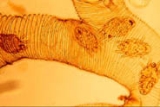
Acarapis woodi
Encyclopedia
Acarapis woodi is a mite
that is an internal parasite of honey bee
s, originally described from the Isle of Wight
. Tracheal mites are related to spider
s and have eight legs. Acarapis woodi live and reproduce in the tracheae
of the bees. The female mite attaches 5–7 eggs to the tracheal walls, where the larvae hatch and develop in 11–15 days to adult mites. The mites parasitize young bees up to two weeks old through the tracheal tube openings. There they pierce the tracheal tube walls with their mouthparts and feed on the haemolymph
of the bees. More than a hundred mites can populate the tracheae and weaken the bees. The mites are generally less than 175 um long, and can only be seen and identified under a microscope.
Other mites that are similar in appearance are Acarapis externus, and Acarapis dorsalis.
Mite
Mites, along with ticks, are small arthropods belonging to the subclass Acari and the class Arachnida. The scientific discipline devoted to the study of ticks and mites is called acarology.-Diversity and systematics:...
that is an internal parasite of honey bee
Honey bee
Honey bees are a subset of bees in the genus Apis, primarily distinguished by the production and storage of honey and the construction of perennial, colonial nests out of wax. Honey bees are the only extant members of the tribe Apini, all in the genus Apis...
s, originally described from the Isle of Wight
Isle of Wight
The Isle of Wight is a county and the largest island of England, located in the English Channel, on average about 2–4 miles off the south coast of the county of Hampshire, separated from the mainland by a strait called the Solent...
. Tracheal mites are related to spider
Spider
Spiders are air-breathing arthropods that have eight legs, and chelicerae with fangs that inject venom. They are the largest order of arachnids and rank seventh in total species diversity among all other groups of organisms...
s and have eight legs. Acarapis woodi live and reproduce in the tracheae
Invertebrate trachea
The invertebrate trachea refers to the open respiratory system composed of spiracles, tracheae, and tracheoles that terrestrial arthropods have to transport metabolic gases to and from tissues....
of the bees. The female mite attaches 5–7 eggs to the tracheal walls, where the larvae hatch and develop in 11–15 days to adult mites. The mites parasitize young bees up to two weeks old through the tracheal tube openings. There they pierce the tracheal tube walls with their mouthparts and feed on the haemolymph
Hemolymph
Hemolymph, or haemolymph, is a fluid in the circulatory system of some arthropods and is analogous to the fluids and cells making up both blood and interstitial fluid in vertebrates such as birds and mammals...
of the bees. More than a hundred mites can populate the tracheae and weaken the bees. The mites are generally less than 175 um long, and can only be seen and identified under a microscope.
Other mites that are similar in appearance are Acarapis externus, and Acarapis dorsalis.

